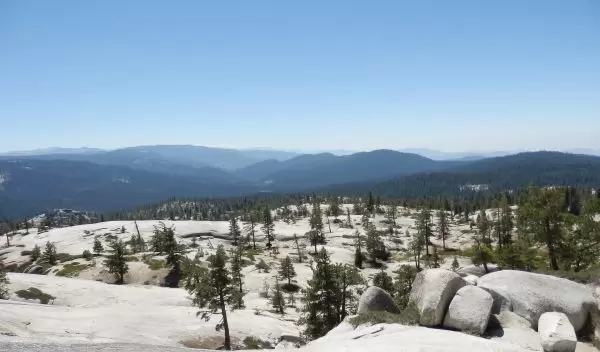
Granite bedrock and sequoia forests 'communicate' in the Sierra Nevada
Find related stories on the National Science Foundation's Critical Zone Observatories (CZOs) at this link.
If a tree falls in the forest and no one is around to hear it, does it make a sound? If it lands on granite bedrock, it does. But beyond the crash of timber onto rock, scientists have found that bedrock and the trees that grow from its weathered soils are, in a sense, communicating.
Bedrock influences forests--and the landscapes of which they are a part--more than was thought, according to researchers funded through the National Science Foundation (NSF) Critical Zone Observatories (CZO) network.
Scientists investigated the factors that influence forest cover in California's Sierra Nevada. Bedrock may be as important as temperature and moisture, they found, in regulating the distribution of trees and other vegetation across mountain slopes.
Geoscientists Cliff Riebe, Jesse Hahm, Claire Lukens and Sayaka Araki of the University of Wyoming recently published results of their study in the journal Proceedings of the National Academy of Sciences (PNAS).
Bedrock and trees in the critical zone
The research took place at the Southern Sierra CZO, one of 10 NSF CZOs funded to unearth the secrets of Earth's critical zone.
Critical zone research looks at how water, life, rock and air interact from the base of the soil to the top of the vegetation canopy.
"The CZOs are providing scientists with new knowledge of the critical zone and its response to climate and land-use change," says Enriqueta Barrera, a program director in NSF's Division of Earth Sciences, which funds the CZO network.
"They're the first systems-based observatories dedicated to understanding how Earth's surface processes are coupled," says Barrera. "The results will help us predict how the critical zone affects the ecosystem services on which society depends."
The water cycle, the breakdown of rocks and eventual formation of soil, the evolution of rivers and valleys, patterns of plant growth and landforms that people see all result from processes that take place in the critical zone.
CZO scientists are investigating the integration and coupling of Earth surface processes, and how they are affected by the presence of fresh water.
The researchers are using field and analytical methods, space-based remote sensing and theoretical techniques.
The CZOs add to the environmental sensor networks in place and planned by NSF, including EarthScope, the National Ecological Observatory Network and the Ocean Observatories Network.
Scientists have known that the critical zone is a complex system in which different components interact at various space and time scales, and in which the rates of processes depend on the nature of those interactions.
Until now, however, researchers have looked at the components individually, especially in the field. The CZOs allow for investigation of the critical zone as a holistic system, rather than as isolated parts.
NSF CZOs are located in watersheds in the Southern Sierra Nevada; Boulder Creek in the Colorado Rockies; Susquehanna Shale Hills in Pennsylvania; Christina River Basin on the border of Delaware and Pennsylvania; Luquillo riparian zone in Puerto Rico; Jemez River and Santa Catalina Mountains in New Mexico and Arizona; Piedmont region of South Carolina; Reynolds Creek in Southwest Idaho; Eel River in Northern California; and linked Illinois, Iowa and Minnesota watersheds.
Composition of bedrock limits plant growth
The Southern Sierra CZO is home to extensive forests and huge exposures of granite bedrock.
"We were puzzled by the patchiness of vegetation on mountain slopes," Hahm says. "Densely forested areas are right next to places with little or no trees and soil.
"Strikingly, these bare areas sometimes occur side-by-side with groves of the largest trees on Earth, giant sequoias."
The researchers determined that bedrock composition acts to limit plant growth.
"Unexpectedly, we found that differences in bedrock composition are just as important in this ecosystem as climate," Riebe says. "That's hard to see without spatial analysis tools and integrated datasets on how vegetation and bedrock change across the landscape."
Plants get some of their nutrients from weathering of minerals as bedrock breaks down into soil. Granite rock, it turns out, contains plant-essential nutrients such as phosphorus.
"The results are important because they demonstrate that bedrock geochemistry is on par with climate as a regulator of vegetation in the Sierra Nevada--and likely in other granite mountain ranges around the world," Riebe says.
Geology of 100 million years ago linked with biology of today
Subtle differences in the cooling history of granite 100 million years ago are likely fueling the biogeochemical interactions that produce today's forest patterns.
Understanding these links is at the heart of critical zone science, says Riebe.
The findings also show that variations in forest cover correspond with differences in erosion rates. They appear to affect the pace at which the Sierra Nevada is wearing down due to the action of water, wind and biological processes.
The results will help efforts to learn how mountain forests are responding to climate-linked changes in temperature and precipitation.
"Most studies point to a shift in vegetation toward higher, cooler elevations," Riebe says. "But changes in climate may be just part of the story.
"Any changes in tree distribution will occur only with the consent of the underlying bedrock."
In the Sierra Nevada, rock meets life meets rock. Or life meets rock meets life.
